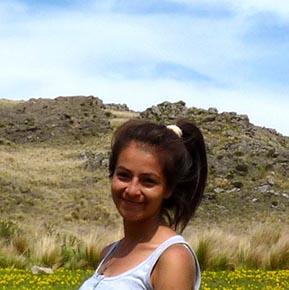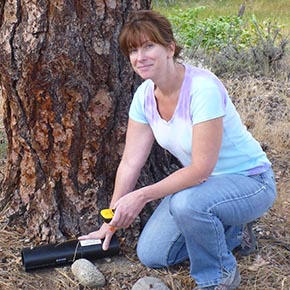|
PBI Expands Acoustic Monitoring for Harbor Porpoises

Additional "ears in the water" are helping document what may be a growing presence of harbor porpoises in local Salish Sea waters.
The Port Townsend Marine Science Center (PTMSC) has joined the Harbor Porpoise Monitoring Network, established by PBI. The Network recently deployed an underwater acoustic monitoring device to record the presence of harbor porpoises in the waters near the Science Center in Port Townsend, on Washington's Olympic Peninsula.
With boat assistance from the Port Townsend Salish Rescue Group, Dr. Cindy Elliser, a PBI marine biologist, installed the device—called a C-POD—which records harbor porpoise echolocation night and day, year-round. The porpoises' sonar signals—inaudible to the human ear—are essential to marine mammals for navigation and foraging.
"Pacific Biodiversity Institute is thrilled to have such a prestigious new member in our Harbor Porpoise Monitoring Network," says Aileen Jeffries, PBI Harbor Porpoise Project director. "PTMSC is a leading marine science education center and will contribute significantly to this project." Dr. Gary Nelson, a PBI acoustic advisor, was instrumental in developing the partnership between PTMSC and PBI.
“This project will provide valuable information about an important sentinel species in the Salish Sea,” notes Jean Walat, PTMSC program director. “We hope to get funding to set up a human component, where volunteers will document sightings of harbor porpoises from the bluffs at Fort Worden, as observers are doing in Anacortes. Doing so allows us to correlate the C-POD’s recorded sounds with the number and behavior of porpoises that volunteers observe.”
Since 2011, Pacific Biodiversity Institute has been using both acoustic monitoring and citizen scientist observers in Burrows Pass, between Fidalgo and Burrows Island near Anacortes, to monitor harbor porpoise activity. PBI recently deployed an additional C-POD in Rosario Strait off Cypress Island. Now, three locations are covered by the C-PODs and continuously monitored. Further expansion of the PBI Harbor Porpoise Monitoring Network is planned for the near future.
Because of the harbor porpoise's reclusive nature, little is known about this small, shy marine mammal—found around the world, including the Salish Sea. Unlike its more gregarious and visible porpoise and dolphin relatives, the harbor porpoise avoids interaction; it does not ride the waves at the bow of boats.
Abundant in local waters into the 1950s, the harbor porpoise had almost disappeared by the 1990s. Now, it may be making a recovery. Anecdotal reports indicate it has been seen as far south as the Nisqually reach and beyond.
The goal of the PBI Harbor Porpoise Project is to understand the population dynamics, behavior, and ecology of the harbor porpoise—and, by extension, its relation to the health of regional waters.
"Because our resident harbor porpoises don't migrate beyond the Salish Sea, they can provide valuable information on the health of our local waters," says Chrissy McLean, PTMSC Marine Program coordinator. "This project helps us answer that baseline question we need to know before we can do other studies—'Just how many porpoises are here?'"
A change in the porpoise population is important information, according to the Puget Sound Partnership (PSP), the agency leading Puget Sound cleanup and recovery efforts. PSP is considering this marine mammal as an indicator of the health of its ecosystem. If the porpoise population is shown to be recovering, it could indicate the Sound is getting cleaner.
The study now has four years of visual data and three years of acoustic recordings. The recent additions of recording locations at Port Townsend and Cypress Island expand efforts to quantify population trends and ocean health in the greater Puget Sound and Salish Sea ecosystem.
The PBI Conservation Science
Intern Program
 |
 |
We are pleased to welcome Gisella Peralta as a
2014 intern, working in Argentina. |
Thanks to Debbie Lewis, 2013 intern, for her great work on the Western Gray Squirrel Project. |
We welcome Gisella Peralta, a young biologist in Cordoba, Argentina as our first conservation science intern in 2014. Gisella has been involved with PBI’s biodiversity research as a volunteer for the last 6 months and now has started a more in-depth program of training and involvement in PBI’s South America project. We are excited that our internship program has expanded to another continent and look forward to working with Gisella.
We are also about to select two or three interns to receive advanced training and work experience in conservation science here in Washington State. We are incredibly fortunate to have some stellar young scientists to choose from. All we need is a little help from you to make it possible to give these talented young people the training and opportunity to start a career that makes a long-term impact in nature conservation. PBI’s internship program provides a meaningful and rich internship experience for young conservation scientists, providing them with the skills and real-life training to do meaningful conservation work and to advance scientific knowledge related to biodiversity. The long-term impact of this program has been demonstrated by the numerous PBI intern alumni who are now working throughout the world in advanced professional capacities to help protect nature, biodiversity and enhance human communities.
We started our conservation science internship program in 1998 and have hosted over 50 interns from the USA, Canada, Europe, Latin America and Asia in the last 16 years. We need your help in continuing this great program! You can donate online by clicking here, or by sending a donation to Pacific Biodiversity Institute, PO Box 298, Winthrop, WA, 98862. You can also learn more about the internship program on our website. If you know someone that is looking for a great opportunity to hone their skills and learn more about conservation science while doing important conservation work, please let them know about this program.
|